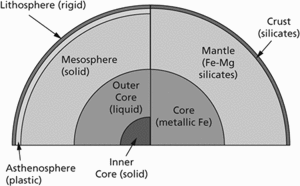The outer rigid shell of a planetary body, including the crust and part of the upper mantle. On the Earth it is distinguished from the asthenosphere beneath, which is a weaker, deformable part of a planetary body. The Earth’s lithosphere, which includes the crust and the upper mantle, is about 150 km deep beneath the continents, and 80 km beneath the oceans.
The earth’s crust and upper region of the mantle. It is fragmented into tectonic plates, which move over the semifluid underlying asthenosphere.
The upper (oceanic and continental) layer of the solid Earth, comprising all crustal rocks and the brittle part of the uppermost mantle. It is generally considered to deform by brittle fracture and if subjected to stresses of the order of 100 MPa. It comprises numerous blocks, known as tectonic plates, which have differential motions giving rise to plate tectonics. The concept was originally based on the requirement for a rigid upper layer to account for isostasy. Its rigidity is variable, but much greater than 1021 P, which corresponds with the underlying asthenosphere. Its thickness is variable, from 1–2 km at mid-oceanic ridge crests, but generally increasing from 60 km near the ridge to 120–140 km beneath older oceanic crust. The thickness beneath continental crust is uncertain, probably some 300 km beneath the cratonic (see craton) parts of the continental crust, but the absence of the asthenosphere in these regions makes definition difficult. Compare atmosphere; hydrosphere.
The Earth’s crust, and that upper layer of the mantle which lies above the asthenosphere. Defant and Drummond (1993) Geology 21, 6 believe Mount St. Helens to be an example of the partial melting of the subducted lithosphere. The strength of the continental lithosphere is likely to be contained within the seismogenic layer; variations in the thickness of this strong layer determine the heights of the mountain ranges it can support (Maggi et al. (2000) Geology 28, 6). Constantin et al. (1996) Geology 24, 8 find that magmatic intrusion is a fundamental process in the construction of the oceanic lithosphere. See Scoppola (2006) GSA Bull. 118, 1 on the westward rotation of the lithosphere relative to the underlying mantle.

The Earth’s constituent layers
Weber State University
- rig
- Rigel
- Righi–Leduc effect
- right
- right action
- right angle
- right-angled triangle
- right ascension
- right-censored
- right-circular
- right derivative
- right-handed system
- right-hand rule(for a dynamo)
- right-hand-side variable
- right inverse
- right lateral fault
- right-linear grammar
- right-regular
- rights
- right shift
- rights issue
- rightsizing
- Rights of Man and the Citizen
- right subtree
- Right, the